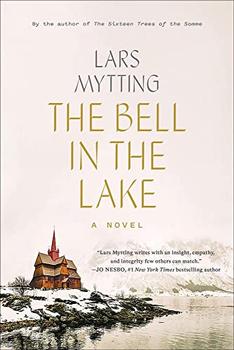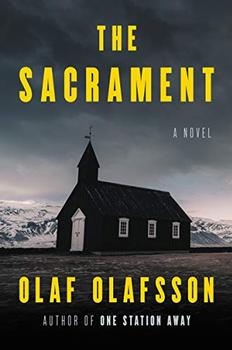Summary | Excerpt | Reading Guide | Discuss | Reviews | Beyond the book | Read-Alikes | Genres & Themes | Author Bio

Sister Bells Trilogy #1
by Lars MyttingA legend from Lars Mytting's Norwegian hometown tells of two centuries-old church bells that, like conjoined twins, were never meant to be separated. Inspired by that story and by the real-life move of a stave church from Norway to what is now Poland (see Beyond the Book), he embarked on a set of three novels in which history and myth mingle to determine the future of the isolated village of Butangen. "Change came slowly," Mytting writes. "The village was twenty years behind its neighboring villages, which were thirty years behind Norway's towns and cities, which were fifty years behind the rest of Europe."
In Butangen in 1880, ancient stories still wield great power. Christianity and local superstition rub shoulders at the village's 12th-century wooden stave church. Along with a crucifixion scene and a tapestry of the Day of Judgment, the church features carvings of Norse myths and imaginary creatures. In the tower are two commemorative bells cast to remember Halfrid and Gunhild Hekne, conjoined twin sisters and local weavers who died on the same day.
Kai Schweigaard, the new pastor of Butangen, feels uneasy with this coexistence of traditional beliefs and Christianity. In fact, he's rather relieved when a government mandate forces him to replace the stave church with a larger building that can fit all his parishioners. The church is to be taken down and reconstructed in Dresden. A German architecture student, Gerhard Schönauer, arrives to make detailed drawings of the church before its dismantling.
Meanwhile, Astrid Hekne, a maid at the parsonage, is completely bound to her father's household, as well as to the pastor's, and it is understood that when (not if) she marries everything that she owns will pass to her husband. "Everything had always been controlled by fathers, or priests. Always men. Every kroner passed through their hands," she thinks. Her flirtation with Kai leads him to ponder whether this country girl could ever make a dignified pastor's wife, but she's also drawn to Gerhard and embarks on a secret romance with him.
As a descendant of the conjoined Hekne twins, Astrid considers herself the guardian of the Sister Bells and feels called to sabotage their removal. Not only are they a family heirloom, they are believed to give supernatural protection to Butangen, such that taking them away might unleash a curse. The novel's title refers to what goes wrong as the bells are transported away from the village. While one bell is later rescued from the lake, the other remains submerged. As Gerhard moves on to document more churches, Astrid must decide where her loyalties lie and to what extent she can influence the future of her village.
Mytting constructs his novel around compelling dichotomies. A wider paradigm shift was beginning in Norway in the late 19th century, with technology and new ideologies driving modernization. Cutting-edge medical procedures versus limited village practices, Christianity versus superstition and male action versus female passivity are pairs of concepts the author gently dissects and subverts. Astrid, a feminist ahead of her time, is in contrast with the pastor's conventional views on gender roles. She also stands for the village's unlearned folk; Deborah Dawkin successfully captures Mytting's use of dialect in her translation, with phrases like "That be nowt but rust" and "Ye can see for yersen (yourself)," making Astrid sound like one of Thomas Hardy's rustic characters.
As much as I enjoyed the book's themes, unique location and blend of genres, I did feel that the central love triangle led the plot into rather melodramatic territory. Some readers may also find certain supernatural events unexpected and jarring. Still, in atmosphere, The Bell in the Lake is reminiscent of Danish author Carsten Jensen's We, the Drowned, another enthralling epic that combines history and legend in an inviting Scandinavian setting and one of my favorite novels.
In May, I took part in an online book club hosted by Mytting's UK publisher, MacLehose Press, and attended by the author and translator. Mytting gave a few hints about the contents of the next two volumes in the "Sister Bells" trilogy. A tapestry that tells the future plays a role in Book 2, while in Book 3 the prophecy that the bells will be reunited is fulfilled, with unpredictable results. Having fallen in love with Butangen and its fictional inhabitants, I am already looking forward to continuing the story.
![]() This review was originally published in The BookBrowse Review in October 2020, and has been updated for the
September 2022 edition.
Click here to go to this issue.
This review was originally published in The BookBrowse Review in October 2020, and has been updated for the
September 2022 edition.
Click here to go to this issue.

If you liked The Bell in the Lake, try these:

by Kiran Millwood Hargrave
Published 2021
After the men in an Arctic Norwegian town are wiped out, the women must survive a sinister threat in this "perfectly told" 1600s parable of "a world gone mad" (Adriana Trigiani).

by Olaf Olafsson
Published 2020
The haunting, vivid story of a nun whose past returns to her in unexpected ways, all while investigating a mysterious death and a series of harrowing abuse claims.
It is among the commonplaces of education that we often first cut off the living root and then try to replace its ...
Click Here to find out who said this, as well as discovering other famous literary quotes!
Your guide toexceptional books
BookBrowse seeks out and recommends the best in contemporary fiction and nonfiction—books that not only engage and entertain but also deepen our understanding of ourselves and the world around us.